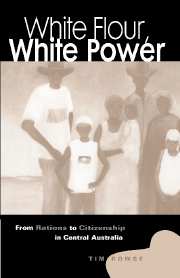Book contents
5 - ‘A Christian Cannot Be a Parasite’
from PART TWO
Published online by Cambridge University Press: 23 October 2009
Summary
The Lutheran task at the Finke River mission at Hermannsburg was ambitious and difficult. Four goals guided their rations-based evangelism between the world wars: first, to keep people away from harmful contacts with settlers, especially from Alice Springs; second, to teach Christian belief and to assert its superiority over Indigenous Law; third, to avoid ‘pauperising’ the recipients of rations; and fourth, to teach Indigenous people a respect for work and, in particular, to impart the skills of certain forms of manufacture valued highly by the Lutherans, such as tanning and bootmaking. It proved difficult to reconcile the pursuit of all four objectives within the one basic technique of influence: rationing. After highlighting the vicissitudes of Lutheran rationing in the 1920s and 1930s, I will suggest that the Lutherans responded to these difficulties by evolving a significant variation on rationing – mercantile evangelism.
The Lutherans believed that their Christian law was superior, a necessary substitute for Aborigines' pagan custom. However, the Lutherans found it difficult to come to a common and consistent view of the priorities of the evangelical program, and the production and issue of food. According to Barbara Henson, Albrecht had repeatedly to justify to the mission board his efforts to establish Hermannsburg's physical infrastructure. ‘ “You can't preach to people if they have nothing on their stomachs,” he would say, pointing to the fact that Jesus fed people as well as taught them. “You have to deal with the whole person. You can't separate body and soul”.’
- Type
- Chapter
- Information
- White Flour, White PowerFrom Rations to Citizenship in Central Australia, pp. 80 - 91Publisher: Cambridge University PressPrint publication year: 1998



